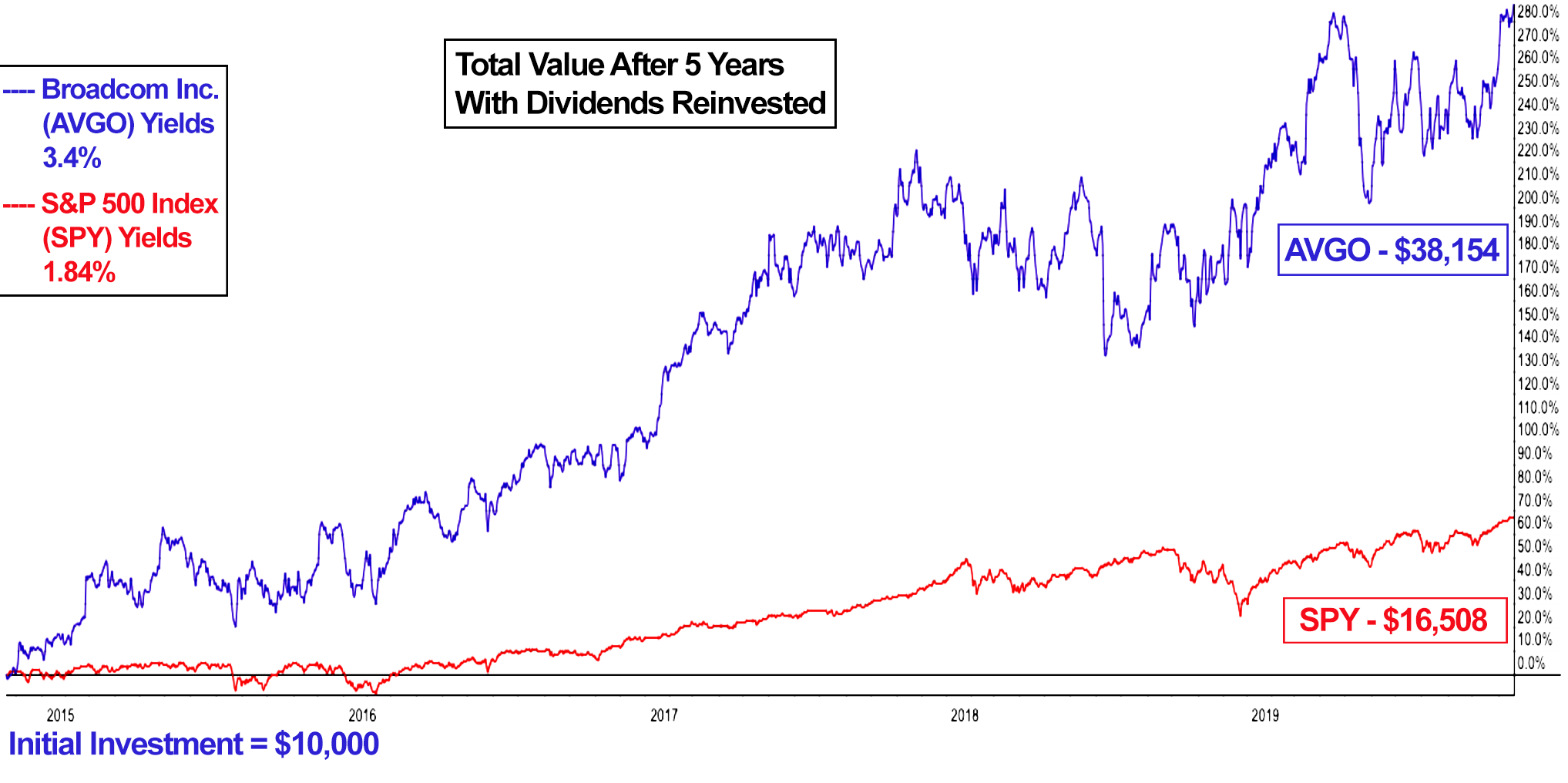Why Dividend Stocks?
The chart to the right is a good example of why so many top performing money managers focus their investing attention on high growth stocks that also pay dividends. The chart compares the returns from the S&P 500 to a stock with above average growth prospects that pays a high dividend (in this case Broadcom, symbol AVGO) over the past five years. The Broadcom dividends are automatically reinvested, effectively boosting the total investment return of the Broadcom position.
Why don’t we hear more about high-growth, dividend paying stocks in the media? I’m convinced there’s one simple reason: MATH. Most investors and virtually all journalists are uncomfortable calculating the combined yield of stock appreciation and regular (but often varying) dividend payments.
Investing in dividend paying stocks is central to a consistent stock investment strategy. Dividends produce a persistency of return each quarter in the form of cash payments. These dividend payments are not subject to vagaries of the rising and falling trends of the stock market. Stocks that do pay dividends tend to be more mature and with seasoned management teams. Many of these companies grow their dividends year after year. Steady dividend growth is strategic because a rising dividend rate tends to increase the stock price over the long term. Good stocks grow their dividends over time while bonds don’t raise their yield. This is very important to keep pace with inflation and to maintain purchasing power.
Quality
Companies that pay dividends are generally more mature. The steady income of these mature companies encourages management to pay and grow dividend income. These are higher quality public companies and on balance have lower volatility in declining markets. Senior companies with dividends tend to fall less and thus portfolio value is supported. Conservative investors benefit from a portfolio of high quality, dividend generating stocks which protect and grow the portfolio with better consistency.
Income
Dividend income has a multitude of benefits to investors. Current income is the most important. The ups and downs of the stock market is unpredictable. Dividend payments are steady and predictable. Every quarter dividend payments are credited to the portfolio like clockwork. The drumbeat of payment consistency is a layer of return that smooths portfolio performance. Dividends are tangible and help measure the stocks value. They are a bird-in-the-hand. Dividend yield is a definable measure of value.
Value
Each dividend paying stock has its own unique levels of over and under valuation. When the stocks yield is low compared to its historical norms, the stock is considered over-valued. When the stock yield is high, under-valuation is suspected. At High Growth Income Monthly Report (HGIMR) a number of metrics are considered when recommending a dividend generating stock. High stock valuation is important to the selection criteria. Timeliness is also critical. When a stock is ready to pivot into a new and important uptrend is the preferred moment to commit to a stock purchase.
Growth
Combining the dividend qualities of a stock with the readiness to emerge into an important uptrend is the main objective of HGIMR. Combining timely Income and Growth into a Total Return strategy is dynamic. It is just as important is to protect stock appreciation as the trend turns downward. A concrete strategy for identifying when a trend is turning from up to down is also critical to capital growth and protection. HGIMR has a specific capital protection strategy for each stock selected for investment.
Your team of Mary Ellen McGonagle and Bruce Fraser have the unique combination of skills to grow and protect capital while generating income as an alternative to very low yielding bonds.

